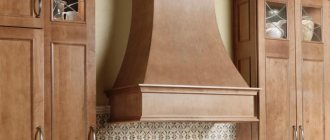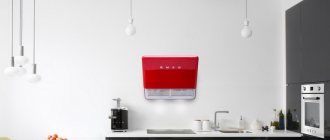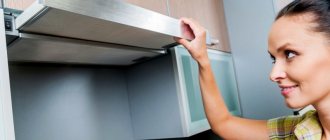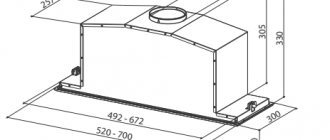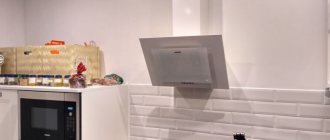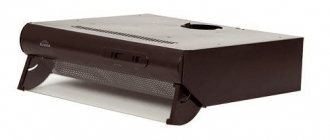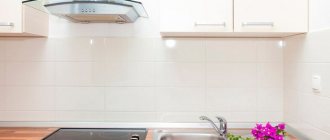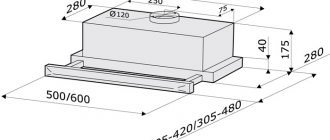Telescopic hood or slider hood for the kitchen: what is it?
This device in a modern kitchen is not a whim, but a necessity. A telescopic hood, like a dome hood, normalizes air exchange in the room, eliminates excess humidity and food odors. Over time, ventilation becomes clogged and loses efficiency, so hoods are an additional means of air purification.
During operation, the flat and compact model slides out of the housing.
Among the variety of devices, the telescopic hood or hood - slider is distinguished by its design.
Hidden – is it good or bad?
A modern telescopic hood has a number of undeniable advantages. The shortcomings are minor and relate more to secondary characteristics.
| Advantages | Flaws |
|
|
Principle of operation
There are several types of hoods. Each of them has different features and operating principles.
Outlet or inlet
The device does not have the function of self-cleaning air, but only removes contaminated air. The supply hood must be connected to the ventilation duct using an air outlet pipe made of corrugated material (in most cases).
- This type of hood is connected to the general ventilation system in the building.
- It is necessary to have an air duct through which the used air flow exits into the general ventilation system.
- Fresh air masses penetrate into the room naturally (through windows or doors), or from other rooms.
- To prevent contaminated air from entering the kitchen again, it is recommended to install anti-return valves.
It is important that there is an individual ventilation duct. If it is not there, then the air is vented directly to the street, outside the building.
Experts advise that before connecting the device to a general ventilation system, carefully study the performance of the latter.
Filtering or recirculating
Recommended for users who do not need a high power hood. The operating principle of these accessories is as follows: first, the contaminated air flow penetrates the filtration system, is cleaned there, and then returns cleaned to the kitchen. In case of heavy contamination, the system may not be able to cope with large volumes of used air masses. About kitchen design in 10 sq. m. read here.
The internal structure of the cleaning system has a carbon filter, which allows you to eliminate unpleasant kitchen odors, soot, and smoke. It is not cleaned or restored from dirt, but must be regularly replaced with a new one.
External filters trap large particles of oil and grease. The devices are made of high-strength metal and can be washed and cleaned when heavily soiled.
Usually this type is equipped with a good motor. Suitable for kitchens in which the ventilation duct is located at some distance from the hob. It is recommended to install recirculation models in old housing stock where ventilation is not efficient enough. This article will tell you about sliding doors to the kitchen.
When purchasing a hood, make sure that filters suitable for this model are also available.
Dimensions: 50 and 60 cm
The height of a telescopic hood often exceeds 40 cm. Therefore, the structure is almost always mounted in hanging cabinets, and only the retractable slider panel remains visible. Before starting installation work, you should read the instructions, which describe in detail the proposed cabinet sizes or free space parameters.
In order for the exhaust device to successfully cope with its tasks, it is necessary to understand the dimensions. The main emphasis should be on the parameters of the hob, the standard width of which varies from 50 cm to 100 cm. Suitable parameters for hoods are also offered: 50, 60, 90 and 120 cm. Read about removing stains from towels here.
The dimensions of the hood must match, according to regulations, the area of the hob or be larger than it.
If the dimensions are set smaller, then the equipment will not cope with its functions of eliminating polluted air - a certain mass will spread further into the rooms. When the width is greater, then all cooking odors and contamination will be completely eliminated.
Not only the transverse dimensions are taken into account, but also the distance of the combined slab from the hood. According to established SNiP, it must be at least 75 cm.
Additional functions
- Models differ in the way they are controlled. The classic is the push-button version. Slider speed control is installed in more modern devices. In operation, preference is given to a sensor hood with a screen, and the equipment is convenient at the stage of cleaning from dirt;
- kitchen hoods can be controlled remotely: using remote controls or voice;
- automation and manual control are comfortable if a slider model is installed or the equipment is mounted with a certain angle of inclination;
- horizontal and vertical hoods are made from a variety of materials, ranging from wood, copper and ending with chrome steel;
- The sizes should be chosen based on the dimensions of the kitchen: small compact models look harmonious in small rooms, and large units in large ones.
Choosing a retractable hood for the kitchen
The fundamental criterion for choosing a kitchen hood is the possibility of installing it in your kitchen. How accessible is it to connect equipment to a ventilation window? What are the dimensions of the required pull-out panel? Installation location: horizontal location above the stove, side installation.
We recommend that you familiarize yourself with: Types of air ducts for kitchen hoods, installation features
When choosing a kitchen hood, pay attention to the following points:
- Power. This characteristic is leading and is indicated in the accompanying documents. Sufficient power guarantees effective ventilation and a healthy microclimate with an average load on the mechanism. According to the norm, complete renewal of indoor air should occur once every 5 minutes.
- The control panel is touch-sensitive, push-button, and responds to sliding the slider at startup. The touch version is more expensive, but more convenient and durable than the button version.
- Dimensions. A retractable hood in working condition should cover the area of the hob. The standard dimensions of a slab rectangle are 50 by 60 cm.
- Noise level during operation . The recommended noise threshold is 45 dB.
- Appearance and additional functions . Additional features include backlighting, the ability to control equipment remotely, and indicators for filter contamination. The more additional functions, the higher the cost of the equipment.
Any model of hood is equipped with lighting. The type of lamp matters here, since it determines the energy intensity of the backlight. The most economical are halogen lamps; they consume only a few watts of electricity per hour.
Manufacturers offer models that determine the heating temperature of the stove and microclimate parameters in the kitchen. Such hoods show the level of air humidity and room temperature. The timer allows you to set the time parameters of the device's operation.
The filter contamination indicator will tell you when it's time to wash the metal filter. The standard interval is once every six months. During intensive use, filters should be washed more often. The need to replace the carbon filter will be heard through the operation of the device - if it is heavily soiled, the noise and load on the motor will increase.
Note! For kitchens equipped with gas stoves, it is more advisable to choose a hood that is connected to ventilation and removes polluted air to the outside environment.
Built-in performance calculation
To quickly make the necessary calculations, you should use this calculation option.
P = S * H * 12
P – power indicator
S – kitchen area
H – ceiling height
12 – air exchange coefficient, according to SES standards
Additional parameters are also taken into account: the expected degree of contamination, type of exhaust device, room layout.
This calculation is presented for a kitchen area of up to 40 m2; it allows you to calculate the most optimal hood power.
Only competent installation of exhaust equipment and correct installation of supply ventilation in combination affect the quality of indoor air. According to the rules and regulations, a hood cannot replace ventilation.
Calculation example
Below is an option for calculating the power of an exhaust device for a kitchen with an area of 12 m2. Let's use the formula.
- S (area) of the kitchen – 12 m2;
- H (ceiling height) – 2.7 m;
- live – 3 people;
- electric stove available (cooking 3 times a day);
- air duct available;
- coefficient for electric stove – 1.5;
- air exchange – 12 times.
Calculation example:
(3*4)*2.7*12*1.5 = 583.2 m3/h
For a kitchen with such parameters, you need an exhaust system with a capacity of approximately 600 m3/h. The range of models on the market is widely represented, so finding suitable equipment will not be difficult.
The best retractable
Three hoods are offered that are considered the most effective. The equipment has positive reviews, quality certificates and licenses. This link will tell you how to choose the right knives for the kitchen.
Hansa OKC 6726 IH
The device is distinguished by its original design and reasonable cost. Other characteristics.
- Width – 43 cm, height – 143 cm, depth – 47 cm.
- Power – 160 W.
- Air channel diameter – 150.
- Operating mode – drainage/circulation.
- Productivity m3/h (maximum) – 620.
- Control type – electronic.
- Speeds – 4 pcs.
- Noise – 69 dB.
- Lighting – halogen (can replace lighting).
- The filter is grease.
The cost of the model is 12,900 rubles.
Disadvantages: the lamps can get very hot, the touch buttons are poorly lit and are sometimes glitchy.
Kronasteel LINA 600 white 4P-S
The cost of the model is slightly higher than average, but the buyer receives a reliable, quiet and productive device. Reviews about this hood are only positive.
- Width – 60 cm, height – 133.2 cm, depth – 43.6 cm.
- Power, W – 198.
- Air duct diameter – 150.
- Operating mode – drainage/circulation.
- Productivity, m3/h – 800.
- Control type – electronic.
- Speeds – 4 pcs.
- Noise – 40 dB.
- Lighting – LED.
- The filter is grease.
You can install a carbon filter and use recirculation. Speed 1 and 2 are sufficient for cooking. The disadvantages include the presence of an additional transformer for lighting, which will take time to replace if it breaks, and the power cord is too tightly clamped by the protective casing during installation. This material will tell you which laminate flooring is best for the kitchen.
MAUNFELD Tower C 60
The device is recommended for kitchens up to 20 m2. Undemanding and stylish, the work surface is made of glass, located at an angle, which is convenient, there is additional lighting above the cooking area, and there is a check valve.
Cost – 9700 rub.
- Width – 50 cm, height – 92 cm, depth – 31 cm.
- Power, W – 250.
- Air duct diameter – 120.
- Operating mode – drainage/circulation.
- Capacity – 520 m3/h.
- Electronic control
- 3 speeds.
- Noise – 54 dB.
- Halogen lamps.
- Filter type: grease filter.
Disadvantages: it is inconvenient to look at the control buttons if you place the hood at a distance of 45 cm (according to the instructions), the slightest dirt is visible on the black surface, it makes a lot of noise at speed 3.
Installation of a telescopic hood
Built-in appliances are associated with a compact device, but telescopic hoods cannot be called small products. The height reaches 40 cm, this is not the limit, so you need to choose a spacious cabinet section for installation. However, there are compact models (32 cm), so when going to the store, stock up on installation dimensions. The telescopic hood comes with special instructions that specify the parameters for installation.
Maintain the height above the hob based on the general rules:
- For a gas stove, the height of the hood above the burners is over 65 cm.
- For other hobs, the parameter is 10 cm lower.
Please note that when gas burns, water with carbon dioxide (during the oxidation of hydrocarbons) and sulfur oxide are released. The latter, meeting condensate, will give a strong acid. This is not a common fact, but it is better to install a telescopic hood to vent air outside. You will need:
- corrugation;
- rectangular or round air ducts.
Most telescopic hoods have a pipe at the top of the body. The diameter is indicated in the specification; look in the store for material for laying the path. If a telescopic hood is chosen, people strive to add decorativeness to the room, or rather, not to lose its appearance. You can make a niche from plasterboard near the ceiling where the air ducts are laid. In this case, the challenge is to avoid disrupting the ventilation system. The usual trick, when the corrugation is inserted into a hole under the ceiling through a grid with a check valve, will not pass; the indicated place will be covered by drywall. A vertical section of the air duct going up to the ceiling will hide a telescopic hood inside.
For the correct functioning of both systems, it is necessary that both are routed separately and operate independently. In the drywall near the ventilation hole, provide an opening for a regular grille. This will ensure normal operation of both systems in joint mode. Now find a grill with a check valve to install.
Please note that a telescopic hood is not an analogue of ventilation. The purpose of the utility networks is not the same. Ventilation provides an influx of fresh air, and the hood cleans the room of odors and soot.
To reduce the size of a plasterboard niche, install with rectangular air ducts. In this case, the performance of the structure will drop, since the cross-section of the tract will sharply decrease. For joining round and rectangular air ducts, special adapters are offered for sale. Plastic is assembled using the tongue-and-groove method, and metal products are overlapped. Seams can be treated with sealant.
When installing a telescopic hood, take the trouble to bring the electrical outlet closer to the telescopic hood. The wire does not hang over the hob. The devices are powered by a standard voltage of 230 V, the power is indicated in the instruction manual and rarely reaches 600 W. The cost of the device starts at 10,000 rubles, most hoods fall in the range of up to 25,000. This will not allow the units to be classified as budget, but given the purpose (interior aesthetics), the segment should not be such.
